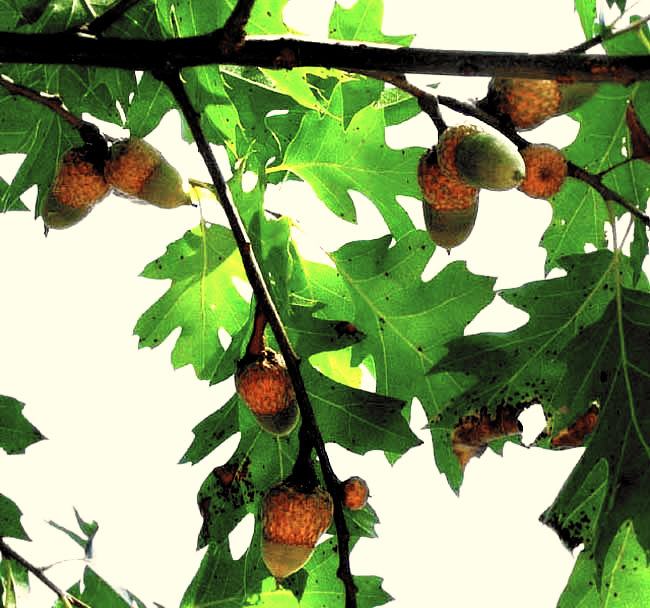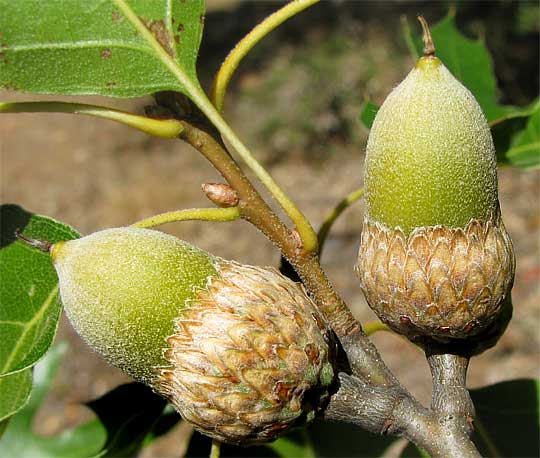Excerpts from Jim Conrad's
Naturalist Newsletter

from the the September 13, 2009 Newsletter, issued from the Siskiyou Mountains west of Grants Pass, Oregon:
CALIFORNIA BLACK OAKS
Few sights impart to me a feeling of wholesome wellbeing more than that of a large, healthy oak tree heavily laden with a robust new crop of acorns. Nowadays our California Black Oaks, QUERCUS KELLOGGII, are loaded with perfect acorns. If you stand beneath one looking upward with sunlight backlighting the leaves you might see something like what's shown above.
A close-up of a couple of acorns can be seen below:

California Black Oaks are common trees here, especially along dry ridges and on steep slopes, able to grow up to 100 feet high. Back East there's a whole cluster of oak species with similar leaves -- the Black, the Scarlet, the Northern Red, the Shumard and more -- but here in the West no oak even comes close to having such leaves, so out here California Black Oaks are even more distinctive than you'd think. Taxonomically they're close to the East's Black Oaks.
In their area of distribution, California Black Oaks often are the main hardwood tree harvested for lumber, yet as recent as the mid 1960s the U.S. Forest Service regarded them as weed trees and in California's National Forests systematically exterminated them by girdling in order to make room for more money-making pine and fir. Eventually the Service's experts figured out that California Black Oaks prosper in certain habitats where pine and fir don't, and the policy was abandoned.
Pine and fir plantations are essentially ecological deserts but California Black Oaks often serve as the most critical forest species for wildlife. Cavities in the trees provide den or nest sites for owls, woodpeckers, tree squirrels, and Black Bears. California Black Oak herbage is heavily browsed by Mule Deer and the acorns are a mainstay for livestock, Mule Deer, rodents, quail and, among birds, especially quail, jays and woodpeckers. Acorns constitute an average of 50% of the fall and winter diets of Western Gray Squirrels and Black-tailed Deer during good mast years. Fawn survival rates increase or decrease in relation to the size of the acorn crop.
Native Americans preferred California Black Oak acorns over those of other species for making acorn meal.
The species is endemic to California's foothills and lower mountains, and here in southern Oregon.
from the July 31, 2005 Newsletter, issued from tCalifornia's Sierra Nevada Foothills:
ACORNS OF CALIFORNIA BLACK OAKS
The oaks above my trailer are California Black Oaks, QUERCUS KELLOGGII.
As the image at the top of this page shows, this oak looks a lot like the East's Black Oak. However, it's profoundly different. For one thing, it sprouts robustly from its roots, so it is highly adapted to life in these fire- prone foothills. For germination, California Black Oak acorns even need to lie on mineral soil or a light duff, similar to ground conditions after a fire.
This isn't to say that California Black Oaks are resistant to forest fires, because moderate fires damage them severely or kill them. This is another species whose fire strategy is to surrender its above-ground body to any conflagration, trusting in its ability to be reborn from its roots.
You might be thinking it's a little early in the season for acorns to be dropping. Well, members of the black oak group need two years for their acorns to mature, so the acorns falling now are over a year old. Also, the acorns rolling off the tin roof next to my trailer are smaller and less developed than those remaining on the branches. The tree is ridding itself of its weakest acorns, aborting them, so that it can focus its energies on its very best ones. Nature is not at all sentimental about these things. She knows she must channel her limited resources to those most likely to survive. She has little sympathy for the weak and malformed.
There's nothing malformed about the acorns remaining on the trees. Each day I look at them and marvel at how large they're getting, how handsome are the cups with their triangular, tan-colored scales, and how voluptuous are the green-turning-mahogany nuts, sharp pointed at their tops like old-time heaps of Dairy-Queen ice cream.